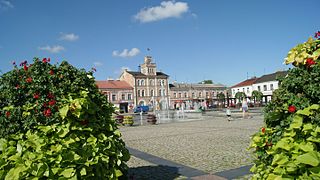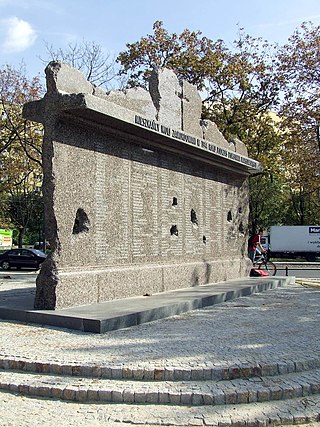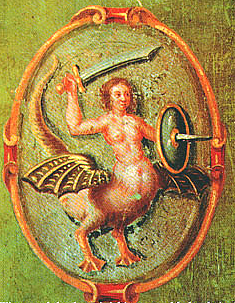
Bloody Sunday was a sequence of violent events that took place in Bydgoszcz, a Polish city with a sizable German minority, between 3 and 4 September 1939, during the German invasion of Poland.

The Invasion of Poland, also known as the September Campaign, Polish Campaign, War of Poland of 1939, and Polish Defensive War of 1939, was a joint attack on the Republic of Poland by Nazi Germany, the Slovak Republic, and the Soviet Union; which marked the beginning of World War II. The German invasion began on 1 September 1939, one week after the signing of the Molotov–Ribbentrop Pact between Germany and the Soviet Union, and one day after the Supreme Soviet of the Soviet Union had approved the pact. The Soviets invaded Poland on 17 September. The campaign ended on 6 October with Germany and the Soviet Union dividing and annexing the whole of Poland under the terms of the German–Soviet Frontier Treaty. The invasion is also known in Poland as the September campaign or 1939 defensive war and known in Germany as the Poland campaign.

The history of Poland from 1939 to 1945 encompasses primarily the period from the invasion of Poland by Nazi Germany and the Soviet Union to the end of World War II. Following the German–Soviet non-aggression pact, Poland was invaded by Nazi Germany on 1 September 1939 and by the Soviet Union on 17 September. The campaigns ended in early October with Germany and the Soviet Union dividing and annexing the whole of Poland. After the Axis attack on the Soviet Union in the summer of 1941, the entirety of Poland was occupied by Germany, which proceeded to advance its racial and genocidal policies across Poland.

The Warsaw Uprising, shortly after the war also known as the August Uprising, was a major World War II operation by the Polish underground resistance to liberate Warsaw from German occupation. It occurred in the summer of 1944, and it was led by the Polish resistance Home Army. The uprising was timed to coincide with the retreat of the German forces from Poland ahead of the Soviet advance. While approaching the eastern suburbs of the city, the Red Army halted combat operations, enabling the Germans to regroup and defeat the Polish resistance and to destroy the city in retaliation. The Uprising was fought for 63 days with little outside support. It was the single largest military effort taken by any European resistance movement during World War II.

Skierniewice is a city in central Poland with 47,031 inhabitants (2021), situated in the Łódź Voivodeship. It is the capital of Skierniewice County. The town is situated almost exactly halfway between Łódź and Warsaw. Through the town runs the small river Łupia, also called Skierniewka.

Around six million Polish citizens are estimated to have perished during World War II. Most were civilians killed by the actions of Nazi Germany, the Soviet Union, the Lithuanian Security Police, as well as the Organization of Ukrainian Nationalists and its offshoots.

Operation Tempest was a series of uprisings conducted during World War II against occupying German forces by the Polish Home Army, the dominant force in the Polish resistance.

The siege of Warsaw in 1939 was fought between the Polish Warsaw Army garrisoned and entrenched in Warsaw and the invading German Army.

The Warsaw Uprising occurred at a stage of the Second World War when it was becoming clear that Nazi Germany was likely to lose. The Uprising ended in capitulation, the deaths of over 250,000 civilians, and only 15% of Warsaw intact; with the benefit of hindsight, many people have argued that it should never have been started. Others have argued that it was inevitable and even crucial for Poland to prove its commitment to the Allied cause. Although Stalin was later to describe it as a "criminal enterprise", just two days prior to its initiation, Radio Moscow had called for the Polish people to rise in arms.

The Lwów Uprising was an armed insurrection by the Home Army underground forces of the Polish resistance movement in World War II against the Nazi German occupation of the city of Lviv in the latter stages of World War II. It began on 23 July 1944 as part of a secret plan to launch the countrywide all-national uprising codenamed Operation Tempest ahead of the Soviet advance on the Eastern Front. The Lwów uprising lasted until 27 July. Shortly afterwards, the Polish troops were disarmed, officers were arrested by the Soviet NKVD and ordinary soldiers either arrested or conscripted into the Soviet-created and controlled People’s Army of Poland (LWP) under Red Army command. Some were forced to join the Red Army, others sent to the Gulag camps. The city itself was occupied by the Soviet Union.

Jan Nowak-Jeziorański was a Polish journalist, writer, politician, social worker and patriot. He served during the Second World War as one of the most notable resistance fighters of the Home Army. He is best remembered for his work as an emissary shuttling between the commanders of the Home Army and the Polish Government in Exile in London and other Allied governments which gained him the nickname "Courier from Warsaw", and for his participation in the Warsaw Uprising. After the war he worked as the head of the Polish section of Radio Free Europe, and later as a security advisor to the US presidents Ronald Reagan and Jimmy Carter. In 1996, President Bill Clinton awarded him with America's highest civilian award the Presidential Medal of Freedom.

The Polish Committee of National Liberation, also known as the Lublin Committee, was an executive governing authority established by the Soviet-backed communists in Poland at the later stage of World War II. It was officially proclaimed on 22 July 1944 in Chełm, installed on 26 July in Lublin and placed formally under the direction of the State National Council. The PKWN was a provisional entity functioning in opposition to the London-based Polish government-in-exile, which was recognized by the Western allies. The PKWN exercised control over Polish territory retaken from Nazi Germany by the Soviet Red Army and the Polish People's Army. It was sponsored and controlled by the Soviet Union and dominated by Polish communists.

During World War II, the German Wehrmacht committed systematic war crimes, including massacres, mass rape, looting, the exploitation of forced labour, the murder of three million Soviet prisoners of war, and participated in the extermination of Jews. While the Nazi Party's own SS forces was the organization most responsible for the genocidal killing of the Holocaust, the regular armed forces of the Wehrmacht committed many war crimes of their own, particularly on the Eastern Front.

In Poland, the resistance movement during World War II was led by the Home Army. The Polish resistance is notable among others for disrupting German supply lines to the Eastern Front, and providing intelligence reports to the British intelligence agencies. It was a part of the Polish Underground State.

Crimes against the Polish nation committed by Nazi Germany and Axis collaborationist forces during the invasion of Poland, along with auxiliary battalions during the subsequent occupation of Poland in World War II, included the genocide of millions of Polish people, especially the systematic extermination of Jewish Poles. These mass killings were enacted by the Nazis with further plans that were justified by their racial theories, which regarded Poles and other Slavs, and especially Jews, as racially inferior Untermenschen.

Kazimierz Leski, nom de guerreBradl, was a Polish engineer, co-designer of the Polish submarines ORP Sęp (1938) and ORP Orzeł, a fighter pilot, and an officer in World War II Home Army's intelligence and counter-intelligence.
Irene Tomaszewski is a Canadian writer, editor and translator of Polish descent living in Montreal, Canada.

The destruction of Warsaw was Nazi Germany's razing of the city in late 1944, after the 1944 Warsaw Uprising of the Polish resistance. The uprising infuriated German leaders, who decided to destroy the city in retaliation.

The history of Warsaw spans over 1400 years. In that time, the city evolved from a cluster of villages to the capital of a major European power, the Polish–Lithuanian Commonwealth—and, under the patronage of its kings, a center of enlightenment and otherwise unknown tolerance. Fortified settlements founded in the 9th century form the core of the city, in today's Warsaw Old Town.

The bilateral relations between Poland and Germany have been marked by an extensive and complicated history.

















